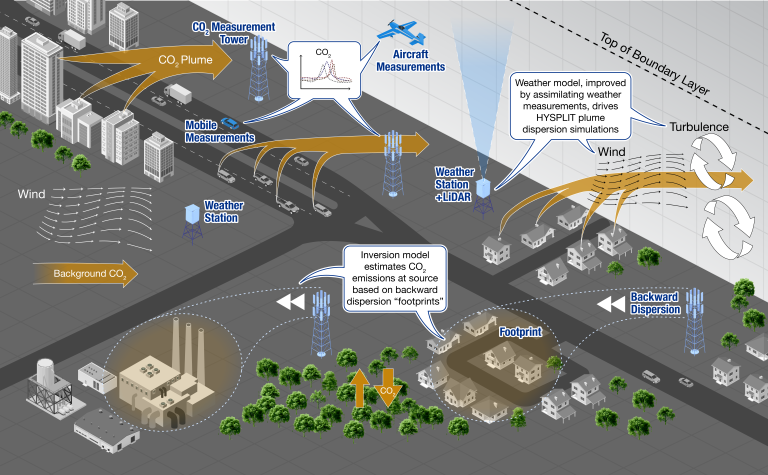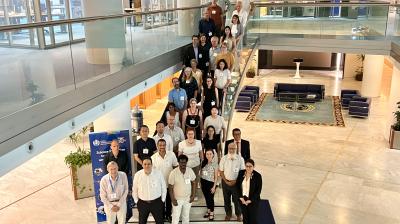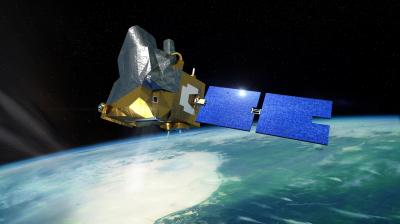New WMO guidelines help cities improve greenhouse gas emission information
The World Meteorological Organization’s Integrated Global Greenhouse Gas Information System (IG3IS) has released the Urban Greenhouse Gas Emission Observation and Monitoring Good Research Practice Guidelines, 2025 edition. The guidelines provide practical tools and methodologies to help cities generate reliable, comparable information on greenhouse gas emissions.

The Urban Greenhouse Gas Emission Observation and Monitoring Good Research Practice Guidelines, 2025 edition, developed under WMO’s Integrated Global Greenhouse Gas Information System (IG3IS), mark an important step in improving how cities understand and manage greenhouse gas (GHG) emissions.
Reliable and consistent information on GHG emissions and sinks is essential as this field transitions from specialized research to operational applications involving a wide range of stakeholders. The guidelines promote consistency and transparency, enabling cities, researchers, and policymakers to evaluate the quality of emissions data and make informed decisions.
Good practice guidelines also help researchers design robust studies and demonstrate the credibility of their methods to funders. As the field matures, such tools may evolve into documentary standards that highlight effective approaches and practices to avoid.
A key component of IG3IS is the development of good practice documentation for different application scales. This supports the community in using compatible methodologies to identify and characterize emissions data across scales. The new urban guidelines provide tools and recommendations that outline what works, what is less effective, and what to avoid when conducting urban-scale GHG observations and analyses.
The guidelines are divided into two parts.
- Part 1 presents core principles and summarizes potential actions, stakeholder needs, and available methods — offering a concise overview for those new to the topic.
- Part 2, Extended Technical Discussions, provides detailed descriptions of 31 techniques for users seeking to implement the methodologies in practice.
In a recent interview with Integrated Carbon Observation System (ICOS), Jocelyn Turnbull, Co-Chair of the IG3IS Steering Committee, editor and one of the lead authors of the urban greenhouse gas (GHG) guidelines, said that the guidelines “are the first step on the path to documentary standards, allowing cities and researchers alike to demonstrate that the emissions information they provide is robust and accurate.”

A central principle of the guidelines is that urban GHG information should respond to stakeholder needs. These may include estimating total city emissions, tracking emission trends, identifying major point sources, attributing emissions to specific sectors, and understanding spatial and temporal patterns. The document also provides insight into the underlying processes that drive emissions, incorporating information from atmospheric observations, activity data, and modelling approaches.

The guidelines aim to serve a broad audience: national, regional, and local governments; regulators; the private sector; international organizations; civil society; educators; the media; and research institutions. Many of these actors already hold valuable data, fostering collaboration between data providers and users and advancing the collective understanding of urban greenhouse gas dynamics.
By promoting standardized methods and data quality, the IG3IS Urban Guidelines help cities and researchers worldwide take evidence-based action on reducing greenhouse gas emissions, contributing to WMO’s broader mission of supporting science-based climate solutions.
To learn more about the new urban guidelines, please watch the webinar recording featuring Jocelyn Turnbull, who explains the guidelines and their applications.
More information:
- Integrated Global Greenhouse Gas Information System (IG3IS)
- Urban Greenhouse Gas Emission Observation and Monitoring Good Research Practice Guidelines, 2025 edition
- Presentation on the Updated IG3IS Urban Greenhouse Gas Emission Observation and Monitoring Good Research Practice Guidelines, 2025 edition.
Note: The Integrated Global Greenhouse Gas Information System (IG3IS) is an initiative under the Global Atmosphere Watch (GAW) Programme, part of the World Meteorological Organization (WMO). It involves various partners and institutions and aims to utilize observational approaches to enhance understanding of greenhouse gas sources and properties at scales relevant to decision-making, including national and local levels. Coordination of IG3IS activities is supported by the Swiss Confederation (MeteoSwiss) and the National Aeronautics and Space Administration (NASA) under award N. 80NSSC23K1349.









